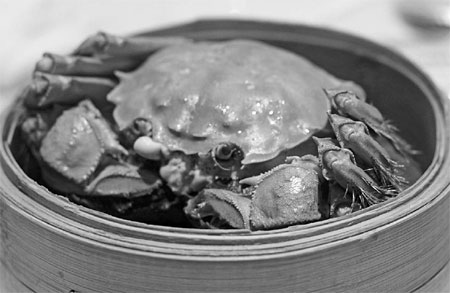Mad about crabs
Updated: 2014-10-27 14:39
By Dong Fangyu(China Daily USA)
|
|||||||||
Seasonal crustaceans from Yangcheng Lake are highlights on Chinese menus now. Dong Fangyu gets to the sweet meat of the matter with a master chef in Beijing.
The first chill of fall signals that one of nature's annual delicacies, hairy crabs, are back in season. The roe now becomes rich and reddish-orange, the meat tender and firm. Food-loving Chinese are so fond of hairy crabs that a popular folk adage goes, "When the autumn wind blows, the legs of crab itch. Smell the chrysanthemums, and savor the crabs."
To celebrate the crustacean, many restaurants in Beijing are giving the crab star billing in the dining room. We visited Noble Court, a Cantonese restaurant eager to lure crab fans with a few new creations on three different set menus as well as a variety of a la carte dishes. We tried the medium-priced nine-course menu, 800 yuan ($131) per person.
The appealing appetizer, chilled crabmeat jelly with Chinese aged rice wine from Shaoxing, Zhejiang province, is delicate but a magnet for our attention. The crabmeat is embedded in the cold jelly stewed with rice wine, a favorite warmer for the stomach at crab feasts.
The roasted suckling pig, marinated rhombus bean with black garlic and braised baby eggplant with homemade sauce also ignited our taste buds. Then the double-boiled wild-bamboo pith soup with fresh matsutake mushroom was a standout, with its aromatic warmth and smoothness whetting our appetites for the important dish: steamed hairy crabs.
The matsutake and mitten crabs are gastronomic reminders of the golden autumn season. Matsutake, also known as pine mushrooms, are prized for their enticing scent, often referred to as "intense", or "pine-like" or "cinnamon-like".
When it comes to cooking matsutake, less is more.
Victor Hu, Noble Court's master Chinese chef, advises not to wash them much or flavor will be lost: Simply wipe the mushrooms with a damp cloth or paper towel. His soup does not have additional seasonings except salt, but the pure broth can be a sensory adventure.
The most traditional way to cook hairy crabs is to steam them, a technique that the chefs of Noble Court embrace to preserve the crabs' innate flavor.
Male crabs have bellies that are somewhat triangular, while females have more oval bellies. We were served male specimens, which are bigger and meatier. Each weighs almost 5 liang (250g), heavier than the market average of about 2 to 4 liang each. And the heavier, the tastier, says Hu. The hairy crabs at Noble Court, the chef says, all come from Yangcheng Lake. Although hairy crabs from other places have been discovered, he believes those from Yangcheng Lake are still superior.
Hu notes that crab farming at Yangcheng Lake has developed into a regulated industry, and the local government is very strict about the water quality and what crabs are fed there. These farms are strictly licensed.
Because of the pleasant climate, clear water, fertile land and the quality water grass and plants the crabs eat, authentic Yangcheng Lake crabs taste better than other varieties," he said. One diner at the restaurant added that this crab is "sweeter than normal ones".
"The gills of a crab can show if it is bred in clean water," said Hu, popping off one specimen's top shell. "You can whitewash the crab's abdomen on the outside, but you cannot change the color of the gills inside."
The experience of eating a crab is messy but delightful. There are different utensils to eat a crab: We used a claw cracker and a pick, which is a fancy digging tool to pull off the legs and claws, and pick out the meat and roe.
Chef Hu advises diners to first eat the legs and claws before opening the top shell, "because the roe in the body is so delicious that if it's eaten first, you would not have any taste for its legs and claws."
It is said that if you eat a crab correctly, all of the body shell and claws can be put back to form an almost intact crab shape after you devour all of the meat and roe.
The creme de la creme moment: savoring the steamed hairy crab's meat with abalone and roe buns. Feel the rich, slippery filling of creamy crab roe wash over your taste buds once you take a nibble.
After this delectable crab-feasting, we were served sweetened ginger tea with longan and red date, always a part of a hairy crab feast. In traditional Chinese medicine philosophy, crabs are very "cooling" foods, so one needs to consume some"warming" foods for balance in the body. That is why hairy crabs are also presented with dipping sauce of brown vinegar and shredded ginger.
Ginger tea is not only a part of a hairy-crab feast, it aids digestion after any meal. Just boil pu'er tea, black tea, brown sugar and slices of ginger together to easily make the soothing and healing ginger tea at home. You can also add longans, red dates or some dried chrysanthemum flowers.
Our set menu also includes braised giant grouper with bird's nest and crab roe sauce, wok-fried South Africa baby lobster with crispy garlic, chili and black beans, and simmered pea-sprout vegetable with flower mushroom and Chinese liquor.
The whole package is good value for money. The crab specials will continue through Nov 30.
If you don't prefer the expansive set menus, you can pick and choose from an extensive range of a la carte crab-based dishes, including braised noodles with crab roe sauce and crisp "YingHua" shrimp (88 yuan), pan-fried matsutake mushroom with shrimp mousse and crab roe (288 yuan), braised crabmeat jelly with "Hua Diao" wine (168 yuan), and braised crab-roe soup with hasma (frog tissue) and bean curd (188 yuan).
Contact the author at dongfangyu@chinadaily.com.cn

|
Food-loving Chinese are so fond of hairy crabs that a popular folk adage goes, 'When the autumn wind blows, the legs of crab itch. Smell the chrysanthemums, and savor the crabs.' Photos by Dong Fangyu / China Daily |
|
To best enjoy a crab's flavor, Victor Hu, Nobel Court's master Chinese chef (center), advises diners to eat the legs and claws before opening the top shell. A pick (left and right) is a fancy digging tool to pull off legs and claws, and to pick out the meat and roe. |
(China Daily USA 10/25/2014 page9)
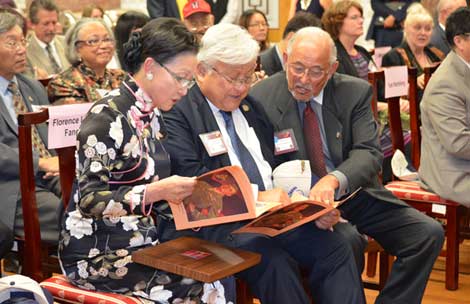
 WWII's Flying Tiger veterans saluted
WWII's Flying Tiger veterans saluted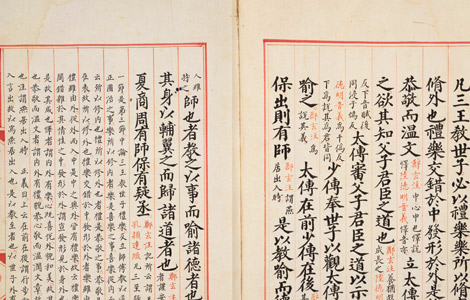
 600-year-old Chinese book found in California
600-year-old Chinese book found in California
 China's growing role in Mexico not a threat to US: expert
China's growing role in Mexico not a threat to US: expert
 Beijingers see blue sky again after smoggy days
Beijingers see blue sky again after smoggy days
 9th Rome Film Festival kicks off
9th Rome Film Festival kicks off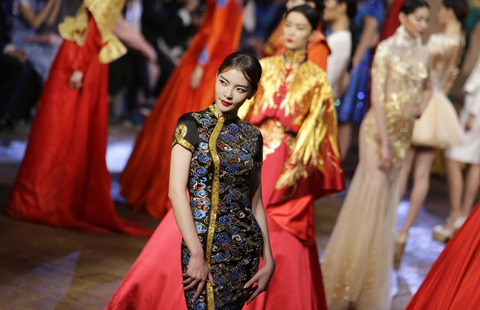
 Highlights of China Fashion Week
Highlights of China Fashion Week
 Remembrance of Flying Tigers & WWII Veterans
Remembrance of Flying Tigers & WWII Veterans
 Lang Lang plays at the UN Day concert
Lang Lang plays at the UN Day concert
Most Viewed
Editor's Picks

|

|

|

|

|
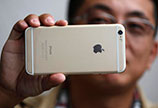
|
Today's Top News
China's growing role in Mexico not a threat to US: expert
Redesigned SAT test 'won't brainwash'
600-year-old Chinese book found in California
Asia, LatAm to lead air travel by 2034
Improving air quality as 'priority'
The road goes on for teacher Levine
Police step up efforts against smugglers
Stricter border check for terrorists
US Weekly

|

|
